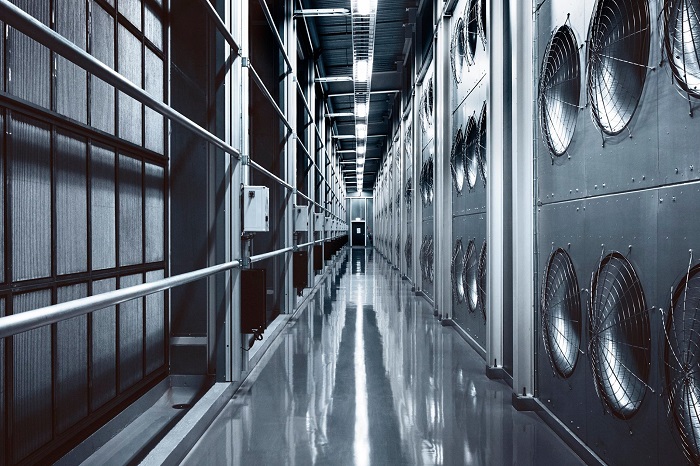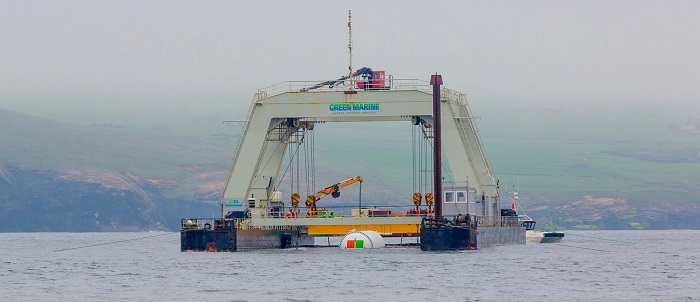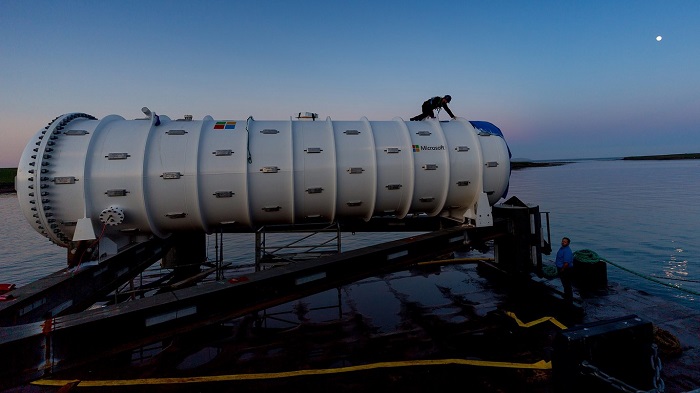ISABEL RUBIO ARROYO | Tungsteno
In 2018, Microsoft submerged a data centre with 864 servers to a depth of 35 metres. Its aim was to test whether it was easier to maintain at the bottom of the sea than on the surface. Two years later it was pulled from the water and the results were promising: the data centre proved to be more stable and energy-efficient than an identical one on the surface. Where is our data usually stored? Does it make sense to submerge it beneath the waves?
Almost all our actions on the Internet generate data. This information is stored on physical servers maintained by large companies such as Google, Apple or Facebook. When choosing the location of a data centre, factors such as temperature are taken into account, as DE-CIX, a leading operator of Internet exchange points, notes. "The cooling of data centres is a major issue, which is a challenge in terms of the efficiency and energy consumption of these buildings," they say.
Mines, churches, bunkers or the Arctic: where our data resides
Servers need to be operational 24 hours a day, a requirement that "generates a lot of heat" and can pose a problem since high temperatures impair their proper functioning. One of the great challenges for tech giants is to control overheating in data centres. "It is common for some companies to locate data centres in cold or remote areas, both for energy efficiency reasons and because of the need for large square metres of space to house their servers," says Theresa Bobis, DE-CIX's southern Europe director.
Tech companies have managed to find chilly—and sometimes quirky—places to store data. Some examples include the Salem Chapel in Leeds (UK), a World War II bomb shelter under the famous Uspenski cathedral in Helsinki (Finland), a nuclear bunker from the Cold War era (Sweden) or a former mine in Norway, where the 120,000 square metre Lefdal Mine Datacenter is cooled by water from the Norwegian fjords and all the energy used comes from renewable sources, according to DE-CIX. To address the cooling issue, some have even taken data centres to the Arctic Circle. Facebook has installed a data centre in the Swedish city of Luleå that has large fans to gather cold air from outside and cool the equipment and servers inside.

Facebook has built a data centre in the small town of Luleå, about 100 kilometres from the Arctic Circle. Credit: Mark Zuckerberg.
Data centres submerged in the sea
This relentless quest to find the perfect place to store our data has taken Microsoft to the ocean floor. Taking advantage of submarine technology and with the help of marine energy experts, the company submerged a data centre inside a cylindrical tank 12 metres long and three metres in diameter in the Orkney Islands off the Scottish coast. The operation involved ten winches, a crane, a barge and a remotely operated vehicle. The site was chosen because the grid there is powered entirely by solar and wind energy.
More than half the world's population lives within about 190 kilometres of the coast, according to Microsoft. By putting data centres underwater near coastal cities, "data would have a short distance to travel to reach coastal communities, leading to fast and smooth web surfing, video streaming and game playing." In addition, Microsoft claims that cold seas make it possible to design energy-efficient data centres.
Does an underwater data centre fail less than one on the surface?
A submerged data centre does not face some stresses that would affect it on the surface and could lead to system failures: for example, corrosion from oxygen, humidity, temperature fluctuations and the jostling of components by technicians. Microsoft, while submerging this data centre, set up an identical data centre on dry land for comparison. Over the two years that the experiment lasted, the underwater data centre suffered only one-eighth as many failures as the one on land, according to the company.

Microsoft in 2018 submerged a data centre with 864 servers at a depth of about 35 metres. Credit: Microsoft.
It is not clear whether, in addition to temperature, other factors may have influenced the underwater data centre to fail significantly less. "We have to figure out what exactly gives us this benefit," says Spencer Fowers of Microsoft's special projects research group. His team is going to study whether the good results are due to the fact that there was no human intervention inside the tank and that the capsule was filled exclusively with dry nitrogen, removing all the oxygen inside.
But what happens when a data centre submerged at a depth of 35 metres fails? Repairing it can be a real challenge. But Ben Cutler, head of special projects at Microsoft, says the model is self-sustaining—servers that fail are simply switched off. "It's designed to be so reliable that we can operate for several years without maintenance," he says.
While the results of this experiment are promising, it is still too early to tell to what extent underwater data centres will play an important role in safeguarding our data. Information is still lacking, for example, on how easy it will be to recover, recycle or replace these data centres once they reach the end of their useful life. Cutler does not believe they will replace the aboveground ones, but he does suggest that they will be an alternative for customers. Who knows if all that data we now say is "in the cloud" will one day end up "at the bottom of the sea."
· — —
Tungsteno is a journalism laboratory to scan the essence of innovation. Devised by Materia Publicaciones Científicas for Sacyr’s blog.
